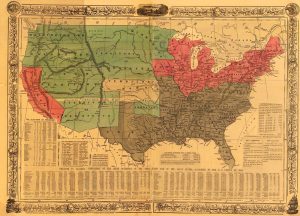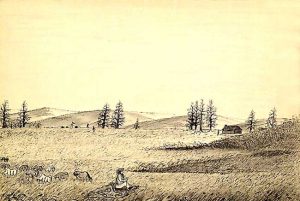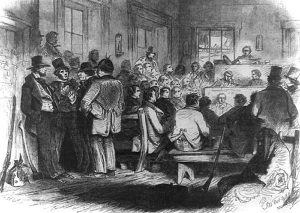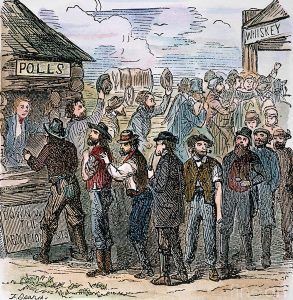Big Springs Convention – September 1855
Topeka Convention – October 1855
Lecompton Convention – February 1857
Leavenworth Convention – February 1858
Wyandotte Convention – February 1859
Kansas was organized as a territory of the United States by the Kansas-Nebraska Act, which President Franklin Pierce approved on May 30, 1854. Scarcely had the echoes of the Congressional debates on that measure died away when the agitation was started for Kansas’s admission as a state. The primary issue was whether Kansas should become a free or a slave state, and in the first efforts for statehood, the Free-State men were the aggressors.
The “Bogus Legislature,” elected on March 30, 1855, might have called a Constitutional Convention at its first session in July 1855, but it did not. One house passed a resolution to that effect, but the other, fearing the result of the election, declined to concur. From a pro-slavery standpoint, this was a fatal mistake.
Never again was the pro-slavery interest so firmly entrenched in the territory. The governor, the courts, the army, and the President and his cabinet and Congress all were with them, and the Legislature might have called a convention with the assurance that the election could be carried by the same methods by which it was elected and that those methods would be approved at Washington. In all probability, if this had been done, Kansas would have been admitted in 1855 with a pro-slavery constitution.
Instead, the pro-slavery men chose to make the fight against admission at this time because so long as the Federal Government was behind them, they could control the Territorial Government, and they believed that by implementing pro-slavery laws, they could drive the Free-State men out of the territory. This was especially true if they could make the charge of treason stick against the promoters of the Topeka Movement.
However, the Free-State men were determined, and though the so-called “Bogus Legislature” was “officially” in charge, a meeting of Free-State men was held at Topeka on September 19, 1855. This meeting called for an election of delegates to a Constitutional Convention to be held at Topeka on October 23, 1855.
An election was held on October 19, 1855, in which a full list of 47 delegates was determined. The pro-slavery people did not participate in the election, and the breach was too wide between the parties. They also contended that a Constitutional Convention could only be called by the Legislature (Bogus Legislature) and ridiculed the whole movement. On the other hand, the Free-State men contended that any convention might draft a constitution; however, informally called, the vital question was its ultimate adoption or rejection by the legal voters at an election held for that purpose. To support their contention, they had the precedent of California, whose constitution was drafted by a convention held under a popular call.
Compiled and edited by Kathy Alexander/Legends of Kansas, updated September 2023.
Also See:




